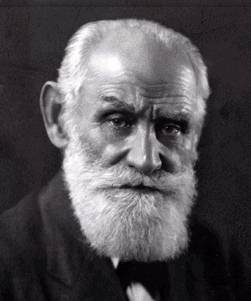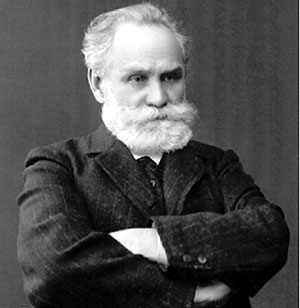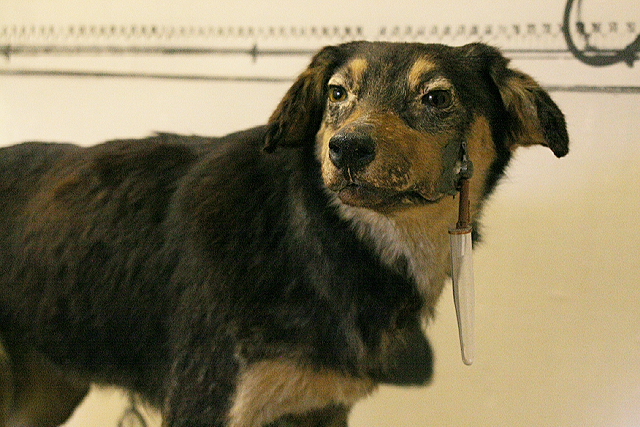<Back to Index>
- Physiologist Ivan Petrovich Pavlov, 1849
- Composer Luigi Cherubini, 1760
- Under Secretary of State for Foreign Affairs Edgar Algernon Robert Gascoyne-Cecil, 1864
PAGE SPONSOR


Ivan Petrovich Pavlov (Russian: Ива́н Пе́трович Па́влов; September 14, 1849 – February 27, 1936) was a Russian physiologist, psychologist, and physician. He was awarded the Nobel Prize in Physiology or Medicine in 1904 for research pertaining to the digestive system. Pavlov is widely known for first describing the phenomenon of classical conditioning.
Ivan Pavlov was born in Ryazan, Russia. He began his higher education as a student at the Ryazan Ecclesiastical Seminary, but then dropped out and enrolled in the University of Saint Petersburg to study the natural sciences and become a physiologist. He received his doctorate in 1879.
In the 1890s, Pavlov was investigating the gastric function of dogs by externalizing a salivary gland so he could collect, measure, and analyze the saliva and what response it had to food under different conditions. He noticed that the dogs tended to salivate before food was actually delivered to their mouths, and set out to investigate this "psychic secretion", as he called it. He decided that this was more interesting than the chemistry of saliva, and changed the focus of his research, carrying out a long series of experiments in which he manipulated the stimuli occurring before the presentation of food. He thereby established the basic laws for the establishment and extinction of what he called "conditional reflexes" — i.e., reflex responses, like salivation, that only occurred conditionally upon specific previous experiences of the animal. These experiments were carried out in the 1900s, and were known to western scientists through translations of individual accounts, but first became fully available in English in a book published in 1927.
Unlike many pre-revolutionary scientists, Pavlov was highly regarded by the Soviet government, and he was able to continue his research until he reached a considerable age. Moreover, he was praised by Lenin and is a Nobel laureate. After the murder of Sergei Kirov in 1934, Pavlov wrote several letters to Molotov criticizing the mass persecutions which followed and asking for the reconsideration of cases pertaining to several people he knew personally.
In later life he was particularly interested in trying to use conditioning to establish an experimental model of the induction of neuroses. He died in Leningrad. His laboratory in Saint Petersburg has been carefully preserved as a museum.
Conscious
until his very last moment, Pavlov asked one of his students to sit
beside his bed and to record the circumstances of his dying. He wanted
to create unique evidence of subjective experiences of this terminal
phase of life. Pavlov contributed to many areas of physiology and neurology. Most of his work involved research in temperament, conditioning and involuntary reflex actions. Pavlov performed and directed experiments on digestion, eventually publishing The Work of the Digestive Glands in 1897, after 12 years of research. His experiments earned him the 1904 Nobel Prize in Physiology and Medicine. These
experiments included surgically extracting portions of the digestive
system from animals, severing nerve bundles to determine the effects,
and implanting fistulas between
digestive organs and an external pouch to examine the organ's contents.
This research served as a base for broad research on the digestive
system. Further
work on reflex actions involved involuntary reactions to stress and
pain. Pavlov extended the definitions of the four temperament types
under study at the time: phlegmatic, choleric, sanguine, and
melancholic, updating the names to "the strong and impetuous type, the
strong equilibrated and quiet type, the strong equilibrated and lively
type, and the weak type." Pavlov and his researchers observed and began
the study of transmarginal inhibition (TMI), the body's natural response of shutting down when exposed to overwhelming stress or pain by electric shock. This
research showed how all temperament types responded to the stimuli the
same way, but different temperaments move through the responses at
different times. He commented "that the most basic inherited
difference ... was how soon they reached this shutdown point and that
the quick-to-shut-down have a fundamentally different type of nervous
system." Carl Jung continued
Pavlov's work on TMI and correlated the observed shutdown types in
animals with his own introverted and extroverted temperament types in
humans. Introverted persons, he believed, were more sensitive to
stimuli and reached a TMI state earlier than their extroverted
counterparts. This continuing research branch is gaining the name highly sensitive persons. William Sargant and
others continued the behavioral research in mental conditioning to
achieve memory implantation and brainwashing (any effort aimed at
instilling certain attitudes and beliefs in a person). The concept for which Pavlov is famous is the "conditioned reflex" (or in his own words the conditional reflex: the translation of условный рефлекс into English is debatable) he developed jointly with his assistant Ivan Filippovitch Tolochinov in 1901. Tolochinov, whose own term for the phenomenon had been "reflex at a distance",
communicated the results at the Congress of Natural Sciences in Helsinki in 1903. As Pavlov's work became known in the West, particularly through the writings of John B. Watson, the idea of "conditioning" as an automatic form of learning became a key concept in the developing specialism of comparative psychology, and the general approach to psychology that underlay it, behaviorism. The British philosopher Bertrand Russell was an enthusiastic advocate of the importance of Pavlov's work for philosophy of mind. Pavlov's
research on conditional reflexes greatly influenced not only science,
but also popular culture. The phrase "Pavlov's dog" is often used to
describe someone who merely reacts to a situation rather than using
critical thinking. Pavlovian conditioning was a major theme in Aldous Huxley's dystopian novel, Brave New World, and also to a large degree in Thomas Pynchon's Gravity's Rainbow. It
is popularly believed that Pavlov always signaled the occurrence of
food by ringing a bell. However, his writings record the use of a wide
variety of stimuli, including electric shocks, whistles, metronomes, tuning forks, and a range of visual stimuli, in addition to ringing a bell. Catania cast doubt on whether Pavlov ever actually used a bell in his famous experiments. Littman tentatively attributed the popular imagery to Pavlov’s contemporaries Vladimir Mikhailovich Bekhterev and John B. Watson, until Thomas found several references that unambiguously stated Pavlov did, indeed, use a bell.
